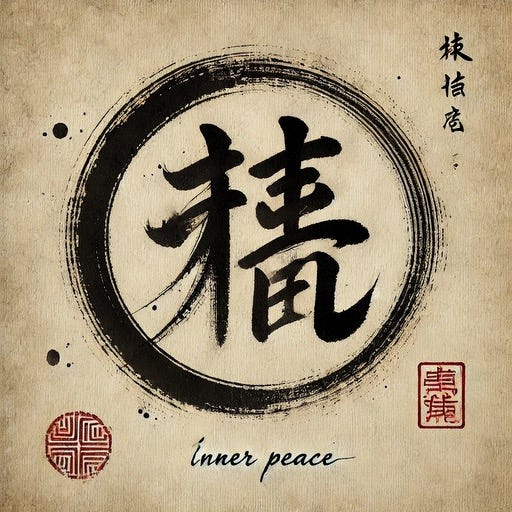My Taoist Teacher Taught Me This Grounding Practice
Its Benefits and Why You May Wanna Consider It
Is it just me or does the pace of life feel like an endless escalator?
Fortunately, a concept called a “meditative pause” offers a powerful antidote to the frenetic energy that surrounds us. My Taoist teacher, with his characteristic blend of wisdom and practicality, introduced me to this transformative practice.
I have found that these brief 3-5 minute periods of re-grounding oneself amidst the cacophony of both internal and external stimuli serve as an elixir for the modern soul, offering a moment of respite and reconnection in a world that rarely slows down.
The beauty of the meditative pause lies in its simplicity and accessibility. It doesn’t require special equipment, a specific location, or even a significant time commitment. Instead, it asks us to momentarily step off the metaphorical escalator of our lives and find stillness, even if just for a few breaths.
What’s really cool is that this practice aligns closely with the Buddhist concept of “bare attention,” a term I first encountered in Phil Jackson’s insightful book “Sacred Hoops.”
Bare Attention and Safe Spots
Phil Jackson, the legendary basketball coach known for his holistic approach to the game, described “bare attention” as a state of mindful awareness, where one observes thoughts and sensations without judgment or attachment.
He introduced the idea of “safe spots” – mental refuges where one can retreat to find calm and clarity. These could be visualizations of serene landscapes, memories of intimate moments, or the simple joy of playing with children.
The key is to have these mental sanctuaries readily available, like emergency exits in the building of our busy minds.
Integrating the concept of meditative pauses with Jackson’s safe spots creates a powerful tool for maintaining equilibrium in chaotic times.
By way of example, imagine being in the midst of a stressful meeting and taking a moment to visualize the gentle lapping of ocean waves against a shore.
Or picture yourself stuck in traffic, using that time to recall the warmth of a loved one’s embrace.
These brief mental escapes, combined with the practice of bare attention, can serve as reset buttons for our overworked nervous systems.
Wisdom from the I Ching: Hexagram 52 - Keeping Still, Mountain
The ancient wisdom of the I Ching offers further insight into the power of stillness, particularly through Hexagram 52, known as “Keeping Still, Mountain.” This hexagram reminds us of the strength found in tranquility and the importance of inner peace.
With a touch of humor, we might imagine the I Ching advising:
“Be like the mountain, steadfast and unmoved. But remember, even mountains enjoy a good laugh now and then – perhaps at the clouds tickling their peaks or the rivers playing hide-and-seek in their valleys.”
The mountain’s stillness is not a passive state but an active form of resistance against the chaos of the world. Similarly, our meditative pauses are not mere moments of inaction but powerful acts of self-care and realignment.
Integrating Meditative Pauses into Daily Life
Now, you might be wondering, “How can I, a mere mortal juggling work, family, and the occasional existential crisis, incorporate these meditative pauses into my life?”
Fear not, for here are some pithy pieces of advice to help you embark on this journey of micro-mindfulness:
🕉️ The Traffic Light Meditation: Me personally, I have been car free for years. But as a driver, try using red lights as cues for brief moments of mindfulness. As you wait, take three deep breaths, focusing on the sensation of air entering and leaving your body. Green means go, but red means grow (in awareness).
🕉️ The Email Interlude: Before opening each new email, pause for 10 seconds. Feel your feet on the ground, straighten your spine, and take a conscious breath. Your inbox won’t implode, I promise.
🕉️ The Bathroom Breakthrough: Let’s face it, the bathroom is often our only sanctuary, a place of escape where we can lock ourselves away from the hustle and bustle of life. So use those private moments for a quick body scan or a few mindful breaths. It’s multitasking at its finest!
🕉️ The Caffeinated Contemplation: As you wait for your coffee or tea to brew, resist the urge to check your phone. Instead, close your eyes and listen to the sounds around you. Bonus points if you can hear your own thoughts brewing alongside your brew .
🕉️ The Doorway Reset: Each time you pass through a doorway, use it as a cue to take a conscious breath and reset your awareness. It’s like a real-life loading screen for your mind.
🕉️ The Meeting Minute: Arrive at meetings one minute early, using that time to center yourself. If anyone asks, just say you’re practicing your “pre-meeting power pose.”
🕉️ The Bedtime Bookend: Before sleep, take 3-5 minutes to reflect on moments of stillness or joy from your day. It’s like leaving a positive voicemail for your subconscious.
Remember, the goal isn’t to achieve some state of permanent Zen-like bliss (although if you do, please share your secrets). Rather, it’s about creating small pockets of awareness throughout your day, little oases of calm in the desert of busyness.
These meditative pauses serve as reminders that while the world may be spinning madly on, we have the power to find our center amidst the chaos.
As you integrate these practices into your life, you may find that these brief moments of stillness begin to expand, coloring your perception and interactions with a newfound sense of clarity and peace.
The escalator of life may continue its relentless ascent, but with regular meditative pauses, you’ll find yourself riding it with greater ease, perhaps even enjoying the view along the way.
So, the next time you feel overwhelmed by the ceaseless motion of the world, remember the wisdom of the mountain, the insight of the basketball coach, and the gentle nudge of your Taoist teacher.
Take a pause, breathe, and rediscover the stillness that resides within you. After all, in a world that never stops moving, the ability to pause might just be your superpower.
Join us during the holiday season as a paid member supporter. Or feel free to tip me some dirty chai latte love here if you feel so inclined.
Your contributions are appreciated!
Every bit counts as I strive to deliver high quality feature articles into your inbox on a daily basis. Never any paywalls, just my raw thoughts which are open to everyone on what it means to be human.
Much ,
Diamond- Michael Scott — aka The Chocolate Taoist







Dōgen introduced the concept of gotsu-za, "to sit like a bold mountain," or "sit boldly like a mountain." This has been meaningful to me in my meditation practice. Your section on "Keeping Still, Mountain" enhances and illuminates gotsu-za for me. l especially like, "The mountain’s stillness is not a passive state but an active form of resistance against the chaos of the world." Thank you.
Thank you! I will use this today for sure!